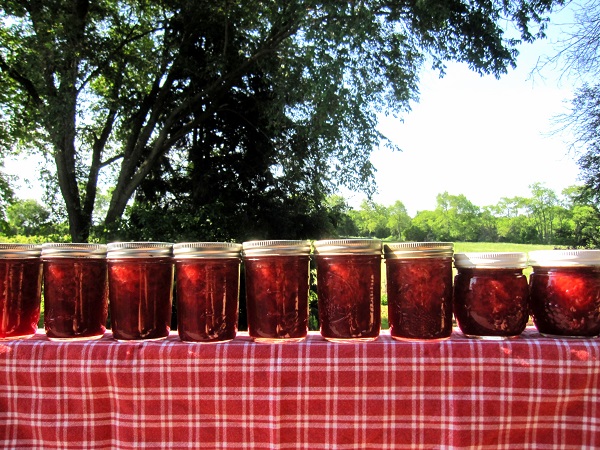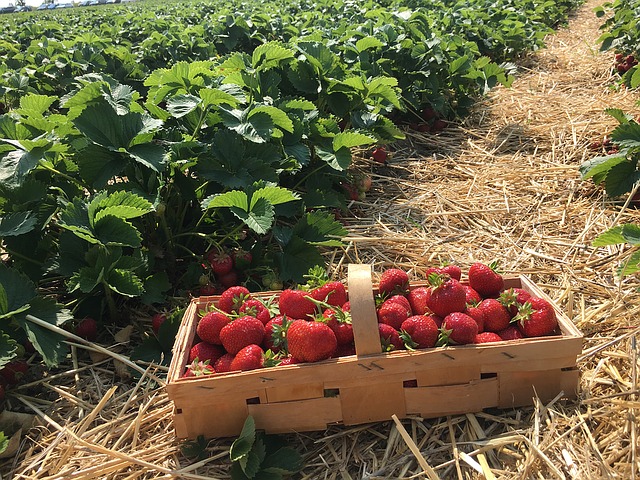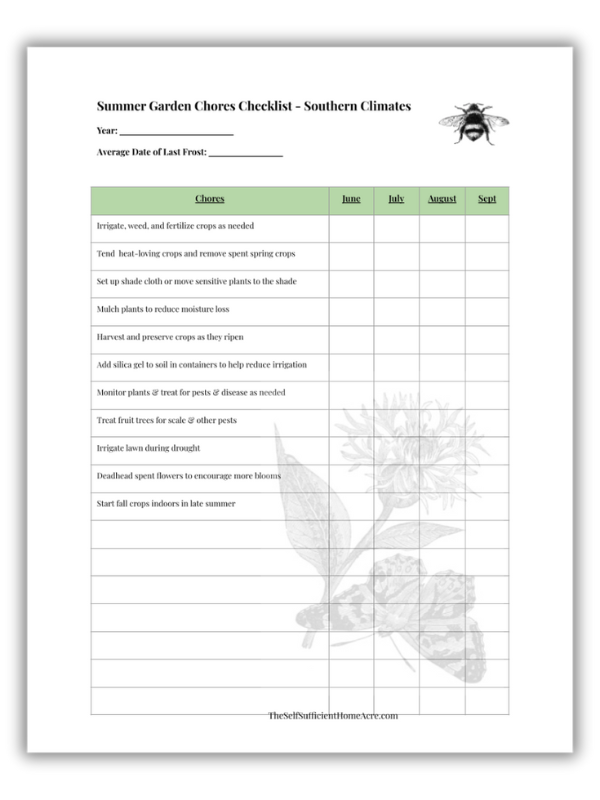
Growing Organic Strawberries
Growing organic strawberries at home will save money and reduce toxins in your diet. Are you tired of paying a premium for organic strawberries at the grocery store? Maybe you’re tempted to purchase the conventionally grown strawberries? Did you know that non-organic strawberries are one of the most highly sprayed fruits you can buy? That’s why they are listed on the ‘dirty dozen.’
So how can you enjoy sweet juicy strawberries without spending a fortune or worrying about the pesticides you’re consuming? Try growing organic strawberries at home! I’ve grown my own strawberries without sprays or artificial fertilizers for many years, and you can too.
In this guide, we’ll take a look at the best strawberry plants for your garden as well as how to plant and care for them. You can even grow strawberries in containers on your patio or in a small urban garden!
This post contains affiliate links or advertisements.
Growing Organic Strawberries for Market
This guide is intended mainly for the homesteader or gardener. When growing berries for sale, you will need to choose varieties that hold up well and have a nice appearance. For local sales, you may be able to choose based on flavor. For the market producer, I recommend investing in a thorough guide to growing organic strawberries for commercial production.
As an Amazon Associate, I earn from qualifying purchases.
Types of Strawberries
- Alpine and wild strawberries – small, sweet-tart strawberries
- June bearing varieties – large berries, produce for several weeks in spring
- Everbearing varieties – medium to large berries, produce 2 or 3 crops each season
- Day-neutral varieties – medium to large berries, produce berries when temps are between 40 and 90 F
Choosing the Best Strawberry Varieties
There are many considerations when choosing the best strawberry varieties for your home garden. One of your main considerations when growing organic strawberries is to select varieties that are disease resistant and will do well in your growing conditions. Here are some other things to think about as you browse through the nursery catalogs:
- What USDA zone do you live in?
- Do you want berries for home production, a U-Pick strawberry patch, or sale at a farmer’s market?
- Will they be used for fresh eating, homemade preserves, freezing, or for shipping?
- When do you wish to harvest your berries – in season or all summer?
- Are you planning to sell them to a gourmet restaurant?
- Would you like to plant berries in a container on your patio?
As an Amazon affiliate, I earn a commission on qualifying purchases.
Selecting Strawberry Varieties for Your USDA Zone
Most nursery catalogs share information on the hardiness zones where each variety grows best. An online catalog may ask for your zip code and then pull up a list of the best strawberry plants for your zone. You may also call your local County Extension office for information about varieties that grow well in your area. It is best to select varieties that will do well in the zones north and south of your area, in case you have extreme temperatures one winter or summer.
I live in zone 5b…strawberry varieties that do well in my area include Allstar, Earliglow, Fort Laramie, and Ozark Beauty, to name a few. For a chart with a comprehensive list of strawberry varieties and where they grow best, check out this Strawberry Varieties list.
Selecting the Best Strawberry Varieties for Your Purposes
Whether you want strawberries for fresh eating at home, making jam, or for sales, there are plenty of varieties to choose from. Let’s take a closer look at the types of strawberries for different uses.
Plant June Bearing Varieties for Large Yields
These heavy yielding plants produce their entire crop during the main strawberry season in your area. For a longer period of harvest, plant early, mid, and late-season varieties. June bearing strawberries are very productive in the home garden and as a cash crop.
Home Use – Great for fresh eating, use in recipes, making preserves, freezing, dehydrating, and canning. Choose varieties with excellent flavor that are good for home food preservation.
Cash Crop – The most productive type of strawberry for U-Pick operations, commercial production, and seasonal sales at farmers’ markets. Choose varieties with good flavor and storage qualities.
As an Amazon affiliate, I earn a commission on qualifying purchases.
Plant Day Neutral, Everbearing, and Alpine Strawberries for Extended Harvest & Novelty Crop
Although these types of strawberries are not nearly as productive, they offer several advantages for both the home gardener and the commercial grower.
Home Use – Day-neutral and everbearing varieties produce an extended harvest for fresh eating. Along with Alpine strawberries, they are great for container planting or small urban gardens. If you love strawberries and want to pick for a longer season, plant these in addition to some June bearing varieties. Choose a variety, such as Evie that can handle more heat in summer.
Cash Crop – These berries allow the commercial and small growers additional sales to the gourmet and local food markets, restaurants, and farmers’ markets where a premium is paid for out-of-season berries. Do a cost analysis to determine if the additional labor and expense incurred will cut into profits too much to be cost-effective. Choose a variety such as Ozark Beauty that produces well all season.
As an Amazon affiliate, I earn a commission on qualifying purchases.
Purchasing Your Strawberry Plants
Buy your strawberry plants from a reliable source that guarantees disease-free plants. Mail-order companies are a great source and you may purchase a few potted plants or bare-root plants in bulk for large scale planting. You’ll most likely pay a shipping fee, but it may be waived for larger orders.
Purchasing at a small local nursery allows you to look at the plants before you buy them. You may find both bare-root plants and potted plants at garden centers, nurseries, and big box stores. Look for bare-root plants with plump crowns that have green leaf buds and viable roots. I recently purchased some bare-root plants from a big box store. The packaging made it difficult to see the roots and I was disappointed in the quality when I planted them. I should have known better than to fall for the sale price.
As an Amazon affiliate, I earn a commission on qualifying purchases.
Bare Root vs Potted Plants
Bare root plants are plant crowns with roots that must be planted within a few days of purchase. Potted plants are grown in potting medium and may be held much longer before they need to go in the ground. If you are putting in a large strawberry patch bare-root plants are the most economical. When starting with bare-root plants, you will need to remove all flowers the first year so that their energy will go into root development rather than fruit production. Potted plants should have their flowers removed for the first month or so and then you may start harvesting from everbearing or day-neutral varieties.
For a small urban garden or a container planting, potted plants are a good choice. They will recover from transplanting quickly and you’ll most likely harvest berries the same year. Many garden centers sell strawberry pots that are already planted and may even have some flowers and berries on them! This is a great way to get fruit quickly. Ask if the plants have been treated with any pesticides or artificial fertilizers before consuming them.
Growing Organic Strawberries in Containers
If you are planning to grow your strawberries in containers, make sure that you have a spot for them that receives at least 6 hours of full sun a day. Strawberries won’t produce well in a shady spot. Choose a container that allows excess water to drain out the bottom and fill it with good quality organic potting soil. You may want to use a potting medium that has silica gel incorporated to hold moisture longer. It might not technically be allowed under commercial organic standards, but this will prevent your plants from drying out as quickly. Plants that dry out too much will stop production and may die. If you are sure you’ll be able to water and check your pots 2 or 3 times a day in hot weather, feel free to skip the silica gel.
As an Amazon affiliate, I earn a commission on qualifying purchases.
Best Strawberries for Container Growing
Day-neutral strawberries are a great choice for growing in containers because you will harvest berries as long as the temperatures are between 40- 90 degrees Fahrenheit. In the sunny south, you may pick strawberries for most of the winter! In cooler climates, you’ll enjoy harvests all summer.
Alpine strawberries are another good choice for containers. These plants produce an abundance of small, sweet-tart berries that are a fun novelty for hanging baskets and small pots.
What could be better than fresh strawberries right from your own patio or small urban homestead?!
Varieties for Containers:
- Seascape – early fruiting variety
- Ozark Beauty – produces well
- Albion – doesn’t put as much energy into runners
- Evie – can handle higher temperatures than most day-neutral and everbearing varieties
Best Containers:
- Strawberry pots
- Hanging baskets
- Large pots that are glazed or plastic to prevent moisture loss
As an Amazon affiliate, I earn a commission on qualifying purchases.
Fertilizing Your Container Grown Strawberries
Provide your potted strawberries with a fertilizer for fruiting plants. You may use a tomato fertilizer or a formula specially made for strawberries. A higher middle number supports fruiting, so look for an N-P-K ratio that is 5-7-5 or 5-7-6 or something similar. Be sure the fertilizer you choose is labeled organic.
As an Amazon affiliate, I earn a commission on qualifying purchases.
Planting Your Organic Strawberries
Choose a spot that receives at least 6 hours of sun a day for your new strawberry bed.
Make sure the soil is well-drained to prevent disease. A raised bed works well for strawberries if your soil is heavy clay or in a low spot that stays wet. Don’t plant strawberries in the same spot where nightshades or strawberries have grown in the last 3 years.
Prepare the bed by turning the soil and removing all weeds and roots. When growing strawberries organically, it is even more important to remove weeds before you start. You won’t want to use non-organic weed prevention such as Preen in your organic patch.
Loamy soil with a fairly neutral pH (between 5.5 and 7) is best for strawberries. Amend the soil with well-rotted manure or compost to increase the organic matter.
As an Amazon affiliate, I earn a commission on qualifying purchases.
Planting Bare Root Strawberries:
For each plant, dig a hole and form a cone-shaped mound in the center. Place the crown on top of the mound and spread the roots out in all directions. Make sure the roots are not crowded. Fill the hole with soil so that the base of the crown is at the soil line. The roots should be under the soil, but the crown should be above ground or the plant may rot. Lightly tamp down the soil and water thoroughly. Avoid watering the crown. If the soil settles and exposes the roots, add more soil, tamp lightly, and water in again.
Transplanting Potted Strawberries:
Dig a hole slightly larger than the pot. Gently remove the strawberry plant from the pot and check to see if it is root bound, meaning the roots have completely filled the pot and are circling around the root ball. If this is the case, gently tease the roots out or use a sharp knife to slice the roots from the top of the root mass to the bottom, about 1/2″ deep. This will stimulate the roots to grow out instead of encircling the plant. Place the root mass in the hole and fill in with soil to the same level that it was planted in the pot. Tamp the soil around the plant lightly and water well. Avoid getting the leaves wet.
Caring for Your Strawberry Patch the First Year
After planting your strawberries, you’ll need to provide them with additional care. Growing organic strawberries requires a bit more work and diligence. Here are the steps to take to keep your patch healthy.
- Mulch with organic straw to hold in moisture and keep the soil cool
- Keep your strawberry bed well-watered, but make sure soil is not staying wet for long periods
- Check soil moisture each day and water as often as necessary
- Hand pull weeds
- Remove flowers from bare-root starts for the first season and potted starts for the first month
- Allow each plant to produce 2 or 3 runners and pinch off the rest
- Train runners to grow in a wide row (matted row system)
- Feed plants with an organic fertilizer for root development and/or side-dress with compost
- Discontinue feeding in hot weather and in fall
- Trim plants in fall to encourage air circulation. Mow with the deck at 3″ to avoid damage to crowns
- For container plants, trim with garden shears
- Remove dead leaf litter to prevent diseases from overwintering
- Mulch strawberry beds with straw in late fall to protect crowns over winter
Tending Your Established Strawberry Patch
The second year you may begin harvesting some berries from your June bearers. Everbearers and day-neutral varieties may begin giving a nice sized harvest. Follow these recommendations for the best results this year, and in the future…
- Side dress plants with compost or well-rotted manure
- Mulch with clean organic straw
- Water plants at the root zone with a soaker hose or drip irrigation to prevent disease
- Remove all but 2 or 3 runners from each plant
- Train runners into wide rows
- Pull weeds by hand and check for signs of disease or pests regularly
- Feed flowering and fruiting berry plants with an organic fertilizer formulated for fruit development
- Add organic straw as needed to prevent fruit from coming in contact with soil
- Harvest fruit every 3 days and don’t allow the fruit to rot on vines
- Stop fertilizing when plants are done fruiting
- Keep beds watered as needed throughout the season
- Remove the runners all season, keeping only 2 or 3 ‘daughters’ per plant
- Trim or mow leaves above crowns in the fall to prevent overwintering disease
- Mulch with straw in late fall to protect crowns
Common Pests and Diseases of Strawberries
Growing organic strawberries requires diligence in checking for pests and disease. Pay close attention to catch signs of infestation before they become a big problem. Here are some of the most common pests and diseases to watch for in your strawberry patch.
- Tarnished plant bug
- Strawberry root weevil
- Slugs
- Picnic beetles
- Spittlebugs
- Powdery mildew
- Leaf scorch, leaf blight, and leaf spot
- Anthracnose
- Red stele root rot
- Verticillium Wilt
- Black root rot
- Parasitic nematodes
- Gray Mold
- Leather rot
Preventing Pests – Growing Organic Strawberries
Most insect pests may be treated in the larval stage with diatomaceous earth. Allowing Guinea fowl and chickens to free range in your strawberry beds during the fall may be one method of pest control. They will eat larvae and adult pests to prevent overwintering. However, poultry may not be allowed in commercial production patches and they should be wormed before allowing to free-range in home gardens. (The links to pests and diseases listed above may give non-organic treatments.)
As an Amazon affiliate, I earn a commission on qualifying purchases.
Preventing Disease – Growing Organic Strawberries
To prevent rots, molds, and wilts: Plant disease-resistant varieties from reliable sources. Do not plant strawberries in a spot where strawberries or nightshade vegetables have been grown in the last 3 years. Make sure soil is well-drained and water the roots, not the entire plant. Water in the morning to allow leaves to dry during the day. Mulch plants with clean straw to keep leaves and fruit off the ground where they may come into contact with fungal and mold spores and bacteria. Rotate your strawberry patch every 3 to 5 years. Remove any diseased leaves and fruit when detected and watch for further problems. Remove plants infected with root rots immediately and destroy them. Replace the soil in containers every 2 to 3 years and sanitize containers. Sanitize tools before using in the strawberry patch and enforce biosecurity measures when possible.
Harvesting and Using Organically Grown Strawberries
Harvest strawberries when they are fully ripe and refrigerate or use them right away. Strawberries don’t keep very long, use them within 3 to 5 days for the best flavor. You may use a 50% vinegar solution to wash berries and kill mold spores. This may prolong refrigerated storage for 2 or 3 extra days.
Strawberries may be preserved for long-term storage. Preservation methods include canning, dehydrating, and freezing. They are great for canned jam or jelly or freezer jam.
As an Amazon affiliate, I earn a commission on qualifying purchases.

Recipes and Preservation Methods for Strawberries
- Fresh Strawberry Pie
- Strawberry Jam – Reduced sugar recipe
- Strawberry Rhubarb Freezer Jam
- No Bake Strawberry Jello Pie
- Canned Rhubarb Strawberry Pie Filling
- Strawberry Wine – Complete Instructions
- Homemade Strawberry Syrup from Strawberry Tops!
- Dehydrate Your Strawberries
- Fermented Strawberry Rhubarb Soda
- Strawberry rhubarb salad
- Fresh Strawberry Vinaigrette Salad Dressing
- Strawberries: Nutrition, Benefits, and Recipes – Over 30 Ways to Use Them!
- Stop! Don’t Throw Away that Strawberry Top – Here are 5 Amazing Uses!
Would you like to read a more personal account of my strawberry adventures? Check out my post Planting Strawberries in My Garden.
As an Amazon Associate, I earn from qualifying purchases.










What can you do to control tarnished plant bug. Where I live no one seems to be able to Grus organic strawberries because of this bug. The only pest usually that is a problem here too. I’m trying neem oil now but still seems like they are getting at half of the berries!
Hi…
The first step is to remove dead plant debris to reduce their overwintering spots. Place white sticky traps throughout the strawberry beds when fruit is developing, if possible. Cover plants with a floating row cover before berries develop (you may need to move some sticky traps!), and keep weeds under control in the garden area to reduce habitat for tarnished plant bugs. Ihope this helps!